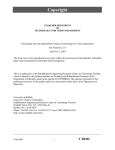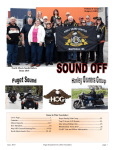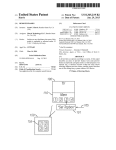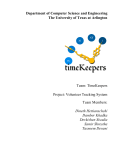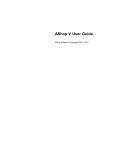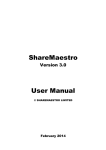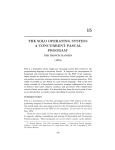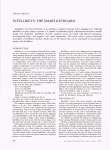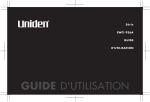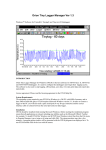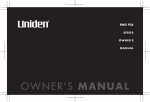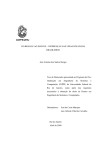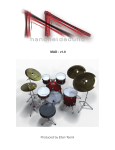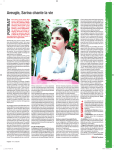Download winning entries in the johns hopkins national
Transcript
WINNING ENTRIES IN THE JOHNS HOPKINS NATIONAL SEARCH FOR COMPUTING APPLICATIONS TO ASSIST PERSONS WITH DISABILITIES The purpose of the Johns Hopkins National Search, a national competition, is to identify and reward the best examples of computer-based applications to assist persons with disabilities. Ten simultaneous regional contests and fairs were held, one in each federal region of the United States. Thirty-one winning entries were invited to compete at the national fair in Washington, D.C. The winning entries are described briefly in order of award. National awards for first, second, and third place, as well as eight additional national awards, are followed by the national merit awards and other top regional awards. NATIONAL AWARDS FIRST PLACE Arjan S. Khalsa Richmond, Call! The IntelliKeys smart keyboard is a flexible, affordable alternative to standard computer keyboards. It is a membrane keyboard comprising 576 small keys that can be grouped to form larger custom keys. The IntelliKeys works with MS-Dos-compatible, Apple Macintosh, and Apple II computers. It comes with six preprogrammed overlays, and custom overlays can be developed. When the user places an overlay on the keyboard, the keyboard automatically recognizes the overlay and interacts appropriately with the computer. The original design of this product provides computer access to many people with disabilities in a variety of settings. SECOND PLACE Jonathan D. Adams Cambridge, Mass. SwitchEnsemble is a music-performance program written for the Apple IIOS. It provides several musical activities for students who have a broad range of physical and cognitive abilities. SwitchEnsemble makes full use of the graphics and sound capabilities of the IIOS and supports a variety of input devices. THIRD PLACE Frank McKiel, Jr. Trophy Club, Tex. This audible feedback scheme allows a blind person using a computer to comprehend and use a windowed graphical user interface in the same manner as a sighted user. The user controls a pointer on the display by using a mouse or similar input device. As the pointer passes over windows, controls, and other graphical features, stereo sounds are generated by special software to convey the 454 identity of the features. The sounds, which may combine musical tones, filtered noise, recorded sound effects, and synthesized speech, serve as replacements for visual sensations. Eric Bohlman Wilmette , Ill. Tiny talk is a memory-resident screen-reader program for blind users of MS-Dos-compatible computers with speech synthesizers in place of the screen display. Tinytalk has advanced features for translating modem software display methods (such as pop-up windows) into speech and requires little computer memory. Carrie Brown, Al Cavalier, Maggie Sauer, and Catherine Wyatt Dallas, Tex. The sound-to-speech translation system using graphic symbols is a computer-based voice-recognition system designed to allow people with mental retardation or severe handicaps to communicate with others and also to control their environment. Users may include people with quadriplegia, spinal cord injury, cerebral palsy, aging problems, arthritis, and neurological disorders. Operation of the system is through speech or vocalizations, switch activation, and keyboard input. In response to user inputs, the system controls operation of electrical appliances and provides digitized speech output. The user may also select customized photographic-quality icons displayed on the monitor via a mouse or track ball. The system may also be used to assess handicaps and to provide feedback in educational applications. Laura Goin, Ted Hasselbring, Victoria Risko, and Charles Kinzer Nashville, Tenn. The Peabody Multimedia Adult Literacy Program capitalizes on the power of integrated media technology. Based on several years of empirical research at Peabody, Johns Hopkins APL Technical Digest, Vo lume J3, Number 4 (1992) this program mediates instruction in word recognition and decoding as well as the comprehension of text passages on contemporary adult topics that are presented on videodisc. The students interact with portions of the program through a voice-recognition device. An animated tutor guides the instruction and provides feedback to the students via a digitized human voice. The program tracks individual student progress and adjusts the instruction accordingly. Lane T. Hauck San Diego, Calif. SAM is a display device that allows nonverbal users to communicate using Morse code by means of a single switch. Originally designed for use by persons with cerebral palsy, the device is compact, portable (it uses four AA batteries), and inexpensive. Messages entered via the switch appear in a twenty-character scrolling display with large, easy-to-read letters. A special feature of the device is that the actual timing of dots and dashes of the Morse code can be extremely "sloppy" and yet still be recognized by the device. Eric Lippke Kirkland, Wash. person's telephone receiver. The user reads the words on the Tonetalker display. No other computer, device, or special telephone is required, and Tonetalker works with any telephone. Voice communication is not affected. Joaquin Vila and Kathleen M. Ahlers Normal, Ill. The purpose of this project, called Read-My-Lips, was to develop a system to enhance the speech-reading abilities of the hearing impaired. The system helps instructors teach the fine nuances of lipreading through an interactive multimedia approach. The system consists of three multimedia instructional modules: (1) Read & See, a series of stories and games that highlight new vocabulary; (2) Babel, which shows front and cross views of a human face synchronized with the outputting of sounds; and (3) Fingerspelling, which allows the student to request any word or number to be finger-spelled. NATIONAL MERIT AWARDS Guy Eddon Fairlawn , N.J. LessonMaker is a tool for creating talking interactive student lessons. It was developed to augment communication and is easily modifiable to meet a student's changing needs. LessonMaker enables a teacher to create custom graphical talking templates for use by students. The SkillBuilders series is a collection of premade talking lessons that are created using LessonMaker. Teachers can use the SkillBuilders as they are, edit them, extend them, or create their own lessons. Danny's Rooms is a multimedia game intended for autistic people that helps focus a user's attention through the use of graphics, music, and animation. The program uses a touch screen to allow direct access to the computer. It also incorporates digitized photographs and voice capabilities to allow the student to see and hear familiar people. One of the special features of this program is that the student retains complete control of the program at all times and does not require any assistance in choosing or playing the games. James S. Lynds Bountiful, Utah Dillip M. Emmanuel Glenn Dale, Md. The Dynamic Asynchronous Remote Computer Interface (DAReI TOO) is a device that gives people with physical disabilities the ability to control personal computers. By connecting DAReI TOO to a computer's keyboard and a user-selected input device, it can provide complete access to the computer. The input device can be a joystick; single, double, or triple switches; an expanded keyboard; or the controllers used with the Nintendo video game. DAReI TOO can be controlled by joystick code, Morse code, scanning, or expanded keyboard. Timing is adjustable so that this device can match the abilities of people with virtually any type of physical disability. This device is a customized internal modem (half card) that brings state-of-the-art telecommunication access to the deaf. It consists of a package that includes software, hardware, and a user manual. The entire work is the product of a deaf engineer who has dedicated several years to its research and design. Although this modem addresses mainly the problems of the hearing impaired, it also has some functions designed to assist the visually impaired and can be interfaced with several braille software packages. Carol J. Sanford Jupiter, Fla. Tonetalker is a low-cost, portable, hand-held, batterypowered device. Used with a telephone, it enables a hearing-impaired person to see messages sent from any Touchtone phone. Tonetalker has a display and a microphone on a suction cup that attaches to the telephone receiver. The hearing-impaired person needs only the keys on a push-button phone to spell words to the Tonetalker device, which is connected to the hearing-impaired f ohns Hopkins APL Technical Digest, Volume 13, Number 4 (1992) Larry R. Goldberg Boston, Mass. The Caption Center (eC), working closely with the National Technical Institute for the Deaf and Tripod, proposes to use the multisensory properties of captioned television in an innovative and highly motivating manner. The project, called CC School, employs deaf children's linguistic competence in American Sign Language (ASL) to improve their competence in English. Instead of watching captioning, students write captions to translate ASL stories. The design of the project requires students to 455 Winning Entries in the f ohns Hopkins National Search consult, in an active way, English language resources, such as dictionaries, as well as their own growing knowledge of the English language. Throughout the captioning process, an instructor or media aide provides ongoing dialogue and feedback. DiHan Cary,N.C. are then displayed on a computer monitor. It can be used as a lipreading aid that supplies supplementary information to normal lipreading by allowing the "listener" to perceive gestures that cannot be seen, such as velar closures that occur in the back of the mouth, for example, "g" and "k" sounds. Another important application is as a therapeutic tool for speech disorders. The device works on the basis of a neural network that maps the relationships between speech sounds and articulatory movements. This computerized, voice-activated, electrical stimulation system can help to restore limited hand functions and enhance mental and motor capabilities of quadriplegics, persons with brain injury, or mentally retarded persons. The battery-powered system consists of a laptop personal computer, a Medtronic neuromuscular stimulator, and an interface device. The Medtronic stimulates paralyzed hand muscles through electrodes placed on the person's forearm. The interface device contains a Covex voice recognizer and a simple switch circuit. The computer system recognizes a user's verbal commands and then turns either on or off the channels of stimulation accordingly to control different hand functions. Say & See is a software program designed to improve articulation for the hearing impaired and persons with speech deficiencies. In response to speech input, the software displays an animated midsagittal picture of the user's vocal tract on a Macintosh II in real time. The computer screen can be split so that the animated display produced by the user can be compared alongside a phoneme snapshot of the idealized vocal tract position. Christopher Hannemann Peapack, N.J. Robin J. Japins Overland Park, Kans. Many of the students at the Matheny School use electronic communication devices . These students need to access their communication devices with the same switches they use for operating their wheelchairs. They also want to be able to access their televisions, VCR'S, lights, and Nintendo entertainment systems with these same switches. Multi-Controller is a wheelchair-based environmental control unit that provides these capabilities in a central location. A custom lap tray will house the display and a programmable infrared controller. The displays are interchangeable, and the function of the controller can be adjusted by changing an EPROM. Thus, if the needs of the student change, the system can be easily modified. Tri-Page is an example of emerging communication technologies now available to the deaf community that address their problems of unemployment and underemployment. This software allows a Telecommunication Device for the Deaf (TDD) to access and leave messages on alphanumeric pagers. The deaf person is alerted to the receipt of messages through a vibrator in the pager. TriPage can bridge the communication barrier of bauds and ASCII, making traditionally incompatible devices accessible to each other. Vicki L. Hanson and Carol A. Padden Yorktown Heights, N .Y. HandsOn is an educational application designed to improve the literacy skills of deaf students. Using students' existing competence in American Sign Language (ASL), HandsOn seeks to promote the acquisition of literacy via the cooperative use of ASL and English. Through the use of interactive video technology, students can switch between English and ASL versions of the same story while engaged in reading and writing tasks. HandsOn has been tested for usability and effectiveness with elementary-school-age children in the United States and Canada, and testing will soon begin in Europe with languages other than English. Judith G. Hochberg, Francis Laroche, Simon Levy, George Papcun, and Timothy R. Thomas Los Alamos, N.M. This computer-based device uses a speaker's acoustics to infer tongue and lip motions during speech, which 456 Sandra E. Hutchins San Diego, Calif. Paul J ubinski Seattle, Wash. The goal of the Virtual Tactile computer display (VIRTAC ) is to provide an affordable means for a blind person to run and interact with publicly released, industry-standard software for MS-Dos-compatible computers. The hardware provides a virtual tactile display window that allows the operator to explore text displays in a braille mode and graphics displays in a direct tactile mode. This design requires no modifications to the computer or to the software being run. Arthur Kaufman and Lloyd H. Woodward Bethesda, Md. This rugged, wearable smart card, PlusTag, contains 64 K of data formatted to carry a patient's medical record. With the aid of MAGIC (Medical Applications Graphic Image Compression), the PlusTag can be programmed to hold the patient's last X ray and electrocardiogram as well as nine full pages of text. The tag can be embossed with the person's name and identification as a medical alert device. This life-saving tool can be worn around the neck like a dog tag or carried on a key chain. PlusTag is intended to aid persons who, because of their disabil- J ohlls Hopkins APL Techllical Digest. Vo lum e 13. Number 4 (1992) Winning Entries in the f ohns Hopkins National Search Itles, are unable to supply medical information about themselves in an emergency. Chris McCanna and Rama Olrech Salem, Oreg. Medicine Manager is a software program designed for people who need to take prescribed medicine but have problems remembering to do so. It will help people achieve the maximum benefit from their medication by sounding a computerized alarm when medicine is due. The program allows a person to enter up to five different medicines and can handle the most commonly prescribed frequencies, that is, one, two, three, and four times per day. Andrew R. Mitz Kensington, Md. Severely retarded children often fail to understand the fundamental concepts of language. Having them touch photographs to obtain toys, food , or other objects is a valuable educational approach that can be augmented by a device that "speaks" the meaning of the photograph with a recorded voice. For some children, the voice feedback is essential for progress. WeeTalk is an electronic device that records or plays back a voice expressly for this purpose. It obviates the need for computer-based and other expensive solutions by employing recently introduced analog EEPROM technology. Verbal feedback can now become an affordable tool for those who need it. Dennis W. Mountford Colorado Springs , Colo. This sound analyzer for the hearing-impaired displays the volume and frequency of sounds. In addition, it has a continuous noise detector for smoke alarms, burglar alarms, alarm clocks, and other devices . Because it is the size of a beeper, the user can take it along wherever he or she goes to "see" sounds. Vera H. Saliba-Pruznick Mountain View, Calif. The Braille Tutor (BT) program teaches braille to both blind and sighted people. It runs on IBM pc's and uses six of the home-row keys as braille dots 1 through 6. With BT, a person can learn to write in three braille codes and practice reading any braille material. Michael J. Socha Tecumseh, Mo. This versatile and inexpensive computer keyboard has a simple, reliable interface and a modular design that allows ergonomically correct one-hand (left or right) touch typing. Or it is possible for a person to design a configuration with simple, off-the-shelf, do-it-yourself construction. Jeffrey Szmanda and William Szmanda Milwaukee, Wis . The Health Care Keyboard is divided into three sections that adjust independently into an infinite number of Johns Hopkins APL Technical Diges(, Vo lume 13 , Number 4 (1992 ) positions. Thus, the keyboard accommodates people with particular requirements for each hand, those requiring the use of a head wand or mouth stick, and those who have suffered cumulative trauma disorders . Gerald Wasserman, Brian Berndt, and Bruce Bresnahan W. Lafayette, Ind. Loss of auditory receptor cells in the cochlea causes deafness. Surgical treatment with artificial ears (cochlear implants) recreates certain properties of normal hearing. The essential concept behind the Purdue Artificial Receptor (PAR) is that it recreates the normal signal processing of auditory receptors. Controlled experiments have demonstrated that PAR processing improved speech perception in every nerve-deaf patient studied. It is currently implemented in hardware as a single-channel, batterypowered, portable, real-time, digital-signal-processorbased computer that simulates natural receptor cell function. Future multichannel PAR'S will add spectral information to improve pitch perception. Mary Sweig Wilson, Bernard J. Fox, Daryl White, Brent Magnant, Timothy Welch, Scott Simon, and Steve Peery Hinesburg, Vt. The Words & Concepts Series consists of six related programs for training and entertainment. Words & Concepts I, II, and III provide training; Concentrate! On Words & Concepts I, II, and III provide reinforcement and use of the same words in a game format. Each of the three Words & Concepts training programs uses a core vocabulary of forty words in six related language instruction activities: vocabulary, categorization, word identification by function , word association, and the concepts of same and different. The Concentrate! programs allow users to practice their new skills in a game format, playing either alone or with a companion. OTHER TOP REGIONAL AWARDS John W. Barrus, Michael Cassidy, and Krisztina Hally Cambridge, Mass. This pen-shaped, bar-code-reading wand connects to a telephone. Using the wand, one can quickly place an order for groceries out of a bar-code-filled catalog and then have the groceries delivered. The wand is easy to use and can be leased for $3 per month. People who have difficulty leaving their homes or who have speech impairments can use the wand to interact with supermarkets, banks, and other organizations, thus increasing selfreliance. David J. Griffiths So. Sutton, N.H. Schoolcraft is a collection of large-character programs grouped by common themes; Math 1 is representative of the series. The quadruple-sized screen and print charac- 457 Winning Entries in the f ohns Hopkins National Search ters allow children and special-needs students to focus their attention and may provide a significant cognitive advantage. Math 1 provides several modules, from interactive to hard copy, each limited to the elementary operations +, -, x, and -7- on positive integers up to 32,768; levels of difficulty vary. Matthew L. Israel, Lisa Ruthel, Michael Bates, and N ancianne Smith Newton Centre, Mass. Little or no software has been designed for use with severely developmentally disabled people, and even less that can be used in a truly self-teaching mode. In addition, because such students often lack communication skills (many cannot speak normally), they are often unable to take standard hearing or vision tests. Behavior Research Institute has designed, tested, and implemented software for this population that teaches communicating by pointing to pictures (the key skill in using a communication board), beginning reading, typing from dictation, beginning mathematics, and skills to enable vision and hearing testing. David 1. O'Neill Dorchester, Mass. An electronic magnifier is frequently used by the partially sighted to enlarge documents. Because of the incompatibilities between the enlarging unit and video adapters, two different monitors must be used, one display to enlarge hard-copy materials, and the other to view computer video. This problem can be overcome by interfacing the enlarging unit with multiple computer video adapters using a single monitor. 1. Conrad Schwarz, Carolina Herfkens, Susan Beaumont, and Richard Hefter Storrs , Conn. The Optimum Resource Reading Program (ORRP) is the first remedial reading program for the personal computer that employs both speech synthesis and voice recognition. Designed specifically for learning-disabled students, its special features help to compensate for the phonological deficits found in most reading-disabled people. The ORRP comprises nine lesson modules of voiced tutorials, exercises, and instructional games to teach word decoding and reading skills. Because students can operate ORRP with a minimum of supervision, this software system allows teachers to serve more students needing basic instruction in reading. Marc D. Simkovitz Brighton, Mass. Visually impaired computer users need a simple solution to allow seeing and using the vast range of text and graphics programs on a personal computer. Large-print DOS (LP-DOS) is a software package that can run on any personal computer or laptop; it can be used anywhere: on the job, at home, or at school. Once loaded, LP-DOS mag- 458 nifies text, spreadsheets, educational software, and video games. It is also the first product to support the Microsoft Windows environment, opening the world of Windows to people with low vision. Mary Sweig Wilson and Bernard 1. Fox Hinesburg , Vt. The Early Vocabulary Development Series consists of three receptive vocabulary training programs and three expressive communication programs using the same words. After students learn the nouns and verbs in First Words, First Words II, and First Verbs, they are introduced to Talking Nouns I, Talking Nouns II, and Talking Verbs, where they can actively use Early Vocabulary Development words to communicate. The programs combine highquality speech output, colorful graphics, animation, accessibility, and teacher control to meet the needs of children and adults with mental retardation, language-learning disabilities, physical handicaps, and autism. Barbara Couse Adams, Mary Sweig Wilson, Bernard Fox, Robert Winchester, Steve Peery, Cole Tierney, and Chris Barrett Winooski , Vt. My House: Language Activities of Daily Living is a software program designed to help children and adults with communications impairments understand and express the language they are likely to encounter in their daily routines. Four different activities are designed to increase the understanding of the labels on various objects and the functions of the objects. Each activity can be carried out within six scenes that represent typical rooms in a house: bedroom, bathroom, dining room, kitchen, living room, and utility room. Selections can be made using the TouchWindow, keyboard, or single switch. Marion Blank, Mary Sweig Wilson, Thomas Bradshaw, Robert Winchester, Bernard Fox, Elaine Ducharme, and Chris Barrett Tenafly, N.J. The Sentence Master addresses the critical problem of difficulty in learning to read or inability to learn to read. By combining insights from linguistic research with the advantages of the computer, it successfully reaches students for whom traditional instructional methods have not worked. It uses innovative, motivating, self-paced materials to lead students to master language skills and enables those students who have been devastated by their reading failure to succeed in a novel way. Arthur Boothroyd, Laurie Hanin, Eddy Yeung, and Oi-Yu Chen New York, N.Y. This video game was designed for speech perception testing and training of hearing-impaired and learningdisabled preschoolers. Requiring only that the user understand the concept of object permanence and the ability to point, it is suitable for children as young as three years Johns Hopkins APL Technical Digest, Volume 13, Number 4 (1992) Winning Entries in the f ohns Hopkins National Search of age. The child pursues an animated toy through a series of scenes, using hearing (or sensory) aids to identify its hiding place. Attention and compliance are encouraged by interesting events (contingent on correct response) and, at the end of a run, by the emergence of the screen character as a real toy that can be taken home. Rosamond R. Gianutsos and Aaron Beattie Sunnyside , N.Y. The Elemental Driving Simulator (EDS) is a low-cost simulation of the information processing demands of driving. It is intended for use by persons with cognitive deficits, including those with head injury and stroke survivors, as well as by the elderly. The system helps the user to identify driving problems and prepare for intervention. Self-judgments are contrasted with norm-referenced measures of steering control, reaction time, adjustment to changes, self-control, and consistency. The EDS operates on MS/Dos-compatible computers with a color graphics adapter, and it features machine-independent timing accurate to hundredths of a second. Its steering wheel, tum signal, and gas pedal are interfaced through the joystick or game port. John D. Nolander, Dwayne Allain, and Thomas Welch Rome,N.Y. Hypercard applications for the Macintosh provide a powerful tool in assisting disabled persons. This entry maximizes the use of Hypercard and the intuitive nature of Macintosh interface to provide a business information management system for learning-disabled, severely dyslexic, and functionally illiterate persons. Icons , voice overlays, and consumer involvement in development create a comprehensive, functional business information management system. The approach is readily transferrable to assist persons with other types of disabilities in handling business and life management activities. Development was sponsored by New York State Office of Vocational Education and Services for Individuals with Disabilities, and the computer architecture and programming were supplied by volunteers. T. V. Raman and M. S. Krishnamoorthy Troy,N.Y. The aim of this project is to demonstrate a software prototype that enables a person to identify figures and curves on a computer monitor using sound cues. This can be contrasted with a screen reader that interprets only ASCII text. Kurt S. Thorn Wading River, N.Y. A measuring cup for the visually impaired announces the volume of liquid it contains in metric or English units. This cup contains an alarm that enables the user to pour a specified volume. When the cup contains less than the set volume, it says "low"; when it contains more than the j ohns Hopkins APL Technical Digest, Vo lume 13, Number 4 (/992) set volume, it says "high"; when the user is within 10 ml of the set point, it says "okay." The pitch of the voice drops as the user approaches the set volume to indicate how much more must be poured. The cup is accurate to 4%. Douglas L. Chute and Scott A. Quillen Devon, Pa. Speech Ware 2.0 is a speech prosthesis for people with communications and motor disabilities. It runs on a Macintosh computer and provides user empowerment over synthesized and digitized speech, telephone and print communications, and household environmental control. A variety of input devices, including single-click operations, are supported, and SpeechWare can be customized to the user's cognitive and physical abilities. Mark Friedman and Richard Lombardi Pittsburgh, Pa. This microprocessor-based guidance system can automatically give a verbal reminder about prescheduled activities, monitor the user 's progress to appropriate destinations in a building, give directions to the destination that are appropriate to the user's current location, verbally prompt the user through activity sequences at the site, and automatically call for human assistance if the user fails to reach the site. Using internal clock and transponder subsystems, this aid, which is worn on a belt or a pendant, can offer verbal assistance either automatically or on demand. Daniel M. Goodman Brinklow, Md. The Arcade Access is a wheelchair-accessible pinball machine system that offers a therapeutic and recreational environment for people with spinal cord injuries, neuromuscular disorders, brain injuries, and other disabilities. It provides a highly motivating, nonthreatening, and selfesteem-reinforcing platform for teaching motor and progressive task-oriented skills; it also helps to develop attention spans. The Arcade Access allows people with a wide variety of physical abilities to compete on an equal basis, encouraging positive interactions and building relationships by breaking down barriers. The system can be operated either manually or by infrared remote control through joysticks, touch pads, sip-and-puff modules, or virtually any controllable part of the body. Carl J. Jensema Silver Spring, Md. A computer board and attachments were developed to translate audio signals of a personal computer into visual or tactile cues. The device works on any IBM-compatible personal computer. Its purpose is to offer deaf persons equal access to computers by use of an inexpensive plugin board to translate the pc 's audio signals into a visual translation. The display is via a ten-segment frequencyto-light display. 459 Winning Entries in the Johns Hopkins National Search Thomas M. Kepple Bethesda, Md. The Move3D software uses data obtained from motion measurement systems to provide quantitative analysis and three-dimensional graphical displays of human musculoskeletal motion. Its purpose is to aid in the understanding of a variety of human motion disorders, thus leading to recommendations and improvements in clinical interventions. Currently, rheumatoid arthritis and post-polio syndrome are the primary patient populations for which the software is used. Gary J. Kiliany Allison Park, Pa. The Dyna Vox gives persons who are unable to speak the ability to communicate. It incorporates a 10-in. LCD graphic display, a touch panel, high-quality speech output (nine different voices), and custom, dynamic display software tailored to the nonspeaking population. Users can ac~ess the device through its touch panel , by external switches, or with a joystick. The Dyna Vox then speaks the message selected by the user in a high-quality synthesized voice. Bernard C. Pobiak Washington, D.C. The Reader Project developed an electronic system of book publishing and reading for print-disabled users. The single-volume book files have the full function and accessibility of the corresponding printed book. The user can read the book files in his or her preferred medium to jump instantly to the original printed page numbers and sections, to leave personal "bookmarks" and notes and to jump to and from the original table of content; and ind:x. The software can be fully adjusted to any adaptive devIce. Each user has a unique key device, and the books are uniquely encrypted for each key, thus eliminating the economic ramifications of pirating. Hamid R. Arabnia Athens, Ga. ~ disable? person using this novel computer input devIce can gIve commands to a personal computer without touching any physical device (i.e., no keyboard or mouse). The system receives input through a pc-based charge-coupled-d:vice (CCD) camera that is built on top of the DOS operatmg system. The major components of the input device are a monitor, an image-capturing board, a CCD camera, and software. These are interfaced with a st~ndard IBM-compatible PC running under the DOS operatmg system. Anthony Bailey, Michael Bollinger, Keith Christian, Lynn Earnhardt, and James U rq uhart Orlando, Fla. The All Children's Playground is a place where chil?ren can learn about abilities, not disabilities. The design I based on encouraging and promoting the interaction 460 and interplay of handicapped and able-bodied children. The playground was designed for children with physical disabilities by students of computer-assisted design for the disabled at Valencia Community College. Because the students are themselves physically disabled, they were able to use their own experiences to determine what would constitute a functional playground. Donna J. Crowley, Philip J. Grise, Mary Sweig Wilson, Bernard Fox, Elaine Ducharmy, and Thomas Bradshaw Sopchoppy , Fla. One of the hardest skills to teach readers, especially hearing-impaired and learning-disabled students, is the concept of main idea. The Readable Stories Series comprises three programs designed to help early (grades 1-2) through intermediate (grade 4) readers derive a main idea from a story as well as increase their comprehension of subordinate details. Each story employs graphics, text, speech, and animation to engage the reader in a highinterest, action-oriented, multisensory experience. Stories can be presented at three levels of linguistic complexity. Reinforcement or corrective feedback follows the responses , and error responses are analyzed to facilitate subsequent instruction. Cindy L. George Lexington, Ky. The Posture Monitor (PM) is a computer-based device designed to support persons who, because of neuromuscular difficulites, have limited physical control for maintaining appropriate posture. The PM addresses the problem of maintaining proper trunk alignment by persons seated in wheelchairs, thus providing a seated position ~at offers greater functionality and enhances physiologI~al processes, such as respiration, circulation, and digestion. The PM consists of a microprocessor-controlled mo~itoring . device, a sensor, an earphone, a remote signaIlIng devIce, and support software. Potentially it could be used as an automated means of monitoring and training proper alignment behavior in a variety of settings and populations. Vincent L. Haley Raleigh, N.C. ~he Ac~ess Power-Pointer is a chin-controlled input deVIce deSIgned to make personal computers accessible to people with spinal cord injuries but who have full use ?f their head and neck. The device is positioned directly In front of the monitor and extends over the front edge of a work surface. A platform tilted at a 60-degree angle supports the keyboard in an optimum position for data entry by a wheelchair-bound user. To operate this prod~ct, the user wheels up to the workstation, takes a position In front of the computer, and rests his or her chin in the c?in rest. To select and input data, the user simply pivots ?IS. or he~ ?ead and the pointer will follow. When the tip IS In pOSItIOn over the desired key, the user has only to puff lightly to activate the powered tip and depress the keys. Johns Hopkills APL Technical Digest. Vo lume 13, Number 4 (1992) Winning Entries in the Johns Hopkins National Search Richard G. Long Lilburn, Ga. This orientation device can aid blind or visually impaired persons to achieve independent mobility. By integrating existing technology in global positioning and computerized mapping databases, it describes to the user, via voice output, the user's CUlTent location and the route to a specific destination. Ann R. McNeal and Dennis McLain Raleigh, N.C. The Reservation Readiness Training Project (RRTP) was created to give persons with disabilities a competitive edge when applying for jobs in the travel industry. Based on the Projects With Industry concept, RRTP offers specific vocational training and is guided by a business advisory council made up of employers in the travel industry. Besides providing training on a simulated computerized reservation system , the RRTP provides four weeks of classroom instruction in communication and interpersonal skills, computer use, city and state code memorization , stress management, and job-seeking skills. Marco K. Nielsen and Bent Givskov Tampa , Fla. MarComm is a computer program that was designed to help severely speech-disabled or physically disabled persons to communicate; it also makes writing easier for people with dyslexia or limited vision. This word-processing software is flexible and easy to use and has adjustments for users with different disabilities. The type is clear, easy to see, and large so that work can be done from a distance from the screen. Use of the program has been made as easy a possible, and only brief instruction is needed. On-screen help is also available while the program is running. computer that greatly enhances the capabilities of two otherwise simple input switches (left and right eyelids, open or closed) to a more complex scheme of sequenced switch pulses. The prototype EWCI was designed to control a powered wheelchair. Jacqueline L. Berg Evanston, Ill. The purpose of Express Yourself Artistically (EYA) is to provide profoundly retarded persons with a vehicle for learning and for enjoying artistic exploration in real-time media. Biofeedback provides the tool for creative control. Three activities are included in EYA: Design Your Image uses live video effects; Directing Music plays instruments and sounds; and Spiral Animations rotates two sine waves into spirals. Via the editor, exercises can be custom designed, and in the file folders, changes in the editor are permanently stored. The graphs function is a real-time graphical display of signal movement for critical signal analysis. Charles Merbitz, Leora Cherney, and Hanspeter Marqui Glen Ellyn, Ill. The Communication Analysis System (CAS) computer software assists the clinician in providing effective and efficient rehabilitation treatment for persons with aphasia or language impairments after stroke or brain injury. It provides automated recording, filing , and graphing of functional (behavioral) data so that the clinician and patient have objective, accurate, timely data displays with which to organize and manage therapy; thus, treatment activities can be regulated to achieve maximum progress. Communication to other professionals and to families is enhanced. The model provides absolute measures of behavioral function; like inches or meters , the data are directly comparable across rehabilitation disciplines, functions, and disabilities. Sheryl S. Ranson Kurt F. Smith and Victoria E. King Tallahassee, Fla. Columbus, Ohio The Isabel system is a software program designed to expand career opportunitie for persons with physical or sensory limitations. The system has two major files: a physical demands file containing detailed information on 180 occupations and an assistive devices file containing information on a variety of assistive devices. The system allows the user to compare his or her physical capacities with the physical requirements of occupations of interest. If a discrepancy is found between an occupation 's requirements and a person 's physical capacities, the system enables the user to search for assistive devices that might eliminate the problem. A key challenge to organizations assisting persons with mental retardation or developmental disabilities in the workplace is the counting of pieces produced. In response to a need to record 500,000 cosmetic packages as they were sorted, a counting device was designed to count pieces automatically as they were dropped into cardboard boxes. The device totally eliminated the need for hand counting and paid for itself on this project alone. On a second project, it was used in conjunction with a sewing machine motor to produce automatically rolled, consistently sized lengths of plastic stripping. The potential for this proven counting device in the work setting is significant. Robin Shaw and Everett E. Crisman Tampa, Fla. Timothy J. Van Antwerp The Eye-Wink Control Interface (EWCI) is an input device based on the timed closings of either one or both eyelids and is intended for use by persons with severe motor impairments. Integral to the unit is a dedicated Benton Harbor, Mich. J ohns H opkins A PL Technical Digest . Vo lLim e / 3. N Limber 4 (1992) This hands-free, voice-dialed cordless telephone is typically for use on a power wheelchair by a quadriplegic person. It offers true handset-quality communication, and 461 Winning Entries in the Johns Hopkins National Search voice programming is not required. Phone activation is under the complete control of the user. Karen L. Wilt and Paul E. Wilt Ann Arbor, Mich. The Cued Speech Teacher-Tutor Translator computer program interacts with a speech synthesizer to display the hand shapes, hand locations , and mouth formations used in Cued Speech which uses fourteen hand positions and shapes to repre ent the forty-one phonemes of the English language. Anything keyed on the computer would be translated into Cued Speech equivalents with graphics. David A. Fisher and C. Ward Bond Baton Rouge, La. This invention is a single-handed chord system that is based on braille and compatible with the Bat chordic keyboard. Use of this system provides speed, accuracy, and protection against developing carpal tunnel syndrome. The chords are analogous to standard braille cells, and the system has access to full 256-character ASCII. Computer users who are blind or who have use of only one hand will fmd the system especially useful, and both English and computer braille are provided for users who are blind or engaged in English-to-braille transcription. Mark I. Bresler Oklahoma City, Okla. The Tamara System was developed for people who are unable to move, speak, or control their surroundings without human or technical assistance. The Tamara System is a wheelchair-mounted control unit that uses a microprocessor, which is configured for each user. It directs control signals to the power wheelchair, speech output communicator, environmental control, computer, and telephone. One switch is used to move among the controls for mobility, communication, environment, and telephone. Depending on the user 's level of ability, a proportional input or a single switch is used to control the operation of the selected device. Programming within the microprocessor assists the user by prompts and programs to speed and simplify operation. James K. Kennedy Round Rock, Tex . This ratiometric blowpipe has an LCD display for data entry. A pressure transducer is used to characterize the force and frequency of the input pressure, and a microcontroller reads the pressure transducer and then drives a two-line LCD display and interface to the Pc. The user advances the characters slowly by applying low pressure and rapidly with high pressure. The top line displays the characters to be selected, and the bottom line shows the mode of operation, that is, numeric, upper case, lower case, function keys , and so on. The unit can be calibrated to the user 's ability. the average person. For blind people, however, the revolution has been slow and expensive. Although several brands of four-function talking calculators have appeared during the last fifteen years, a talking programmable scientific calculator was either unavailable or available only at a high cost (about $500.00 for a specially built calculator). This portable interface converts the infrared printer output of an off-the-shelf HP28 series scientific calculator to spoken English. Brian P. Melton Houston , Tex. The Speech Aid Device (SAD) was designed for use by vocally impaired persons who have the use of at least one hand to communicate freely. The user spells the desired word or phrase to be spoken using a hand-held keying device and then signals the SAD to process the input data for speech. The only training required is to learn the positioning of the fingers for each letter of the alphabet. In extreme cases, the hand-held keying device and finger positioning can be modified to fit the user 's hand. Wayne L. Schmadeka and Gerry Woelfel Houston , Tex. LitTech combines software and audio cassette tapes for teaching reading and related skills. The program is individualized, multisensory, mastery-oriented, and cost-effective. It is appropriate for students from the preprimary through ninth-grade levels. LitTech uses one on-site computer to generate individualized lessons for many students each day. Each lesson is a set of worksheets with an accompanying audio cassette. The computer program handles placement, prescription of remedial lessons (based on weekly mastery testing), and report generation so that the teacher is largely free to encourage and assist students. David E. Altman Lincoln, Neb. Use of the Mechanically Actuated Rotary Linear Adjustable Arm (MARLA) will allow a physically disabled person to adjust the height and angle of his or her computer monitor by means of a switch. The switch mechanism can range from a sip-and-puff switch to any kind of microswitch. Robert D. Gunn Beatrice, Neb. A single-action switch with the necessary BASIC subroutine was developed so that physically limited, mentally retarded adults would have access to the computer and computer programs designed specifically for each person. This was possible through the modification of computer joysticks for use with the Commodore 64 computer system. Martin G. McCormick Stillwater, Okla. Glenn Nielsen and Gregory G. Harvey Columbia, Mo. The development of the electronic calculator has revolutionized simple arithmetic and higher mathematics for Braille and audio-recorded materials cannot meet the information needs of the blind population. The goal of 462 f ohns Hopkins APL Technical Digest, Volume 13, Number 4 (1992) Winnin g Entries in the Johns Hopkins National Search Interactive Talking Books is to provide reference, educational, and leisure reading materials to the blind and visually impaired on CD-ROM disks. The program employs a simple-to-use and inexpensive consumer CD-ROM platform to provide indexed reading material spoken by a computer or recorded human voice. The user would have a simple remote control that responds to spoken menus to select the material of interest. Theodore W. Cannon Golden, Colo. The inventor has developed special software to enable his 18-year-old, cerebral-palsied son to communicate using a speech synthesizer, monitor, and printer. Either codes or the words themselves are entered via a keyboard with a heads tick. The system is unique in that the encoded word information is read into the communication program from a database file. Individualized database files are easily generated, edited, listed, and analyzed using the features of database software such as Appleworks database or DBase. Theodore W. Cannon Golden, Colo. This personal computer system can be installed on a power wheeelchair to provide full-time computer access by a wheelchair user with special needs. The computer system, which can be powered from the chair's battery, includes a keyboard, printer, text -to-speech system, and small monitor. David A. Detary Lakewood, Colo. The Pi Vu (pie view) Flash Reading Technology is an interface between a computer and its user that presents text information, either one word or several words at a time, through a fixed window on the computer screen. In this way, complete thoughts and ideas can be communicated to persons with limited vision, slow comprehension, or limited movement; it can also be used by deaf persons. The user controls all aspects of the information displayed: content, size, speed, and direction of travel (through the keyboard, mouse, or joystick hardware). Individual control allows the user to receive the electronic information at the speed and size best suited to his or her needs and ability. Kelli C. Foster Orem, Utah Daisy Quest is an interactive software program designed to evaluate and train phonological awareness, which is defined as awareness of the phonological structure of the words in one's language. Studies have shown a strong relationship between phoneme awareness and success in the beginning stages of reading and that training in this area will reduce the incidence of reading failure. As children use Daisy Quest, they master specific skills while searching for a dragon named Daisy, who likes to play hide-and-seek. Daisy Quest is a highly interactive program that presents material via high-quality digitized speech as well as graphics without text and Johns Hopkins APL Technical Digest. Vo lume 13, Number 4 (1992) accepts input from children via a mouse. A tutorial for each skill is included as part of the program. After completing the tutorial, the child can demonstrate mastery of the skill by moving to another area of the program and answering specific questions. George Kerscher Missoula, Mont. The research and development department of Recordings for the Blind (RFB) has established a protocol for the production of computerized books from publishers ' source files. Print-disabled people would thus have access to information on a PC , readable through synthetized speech, enlarged print, or electronic braille. Mathematics and science books are particularly targeted for this type of production. Zan Merrill, Bill Sanderson, and Bryan Snow Logan, Utah The purpose of SHARE (Ski*Hi Acquisition and REtrieval) is to give efficient access to information on a variety of topics associated with persons with disabilities. It provides professionals, care givers , and families with the necessary information for interactions with persons with disabilities, ranging from daily activities to designing a state-of-the-art curriculum or lesson. Briefly, the system works by acquiring information through standard library and publication resources; the information is then read, categorized by topic, and entered into the system. Marlo E. Schuldt Orem, Utah A small, easy-to-use, portable, inexpensive electromyograph (EMG) was developed to measure minimal muscle recruitment of multiply handicapped persons with the purpose of allowing them to interact, using a single switch or a personal computer. This system provides the handicapped with exciting new opportunities to improve learning capabilities, enhance leisure time, enrich lifestyle, and provide opportunities that existing technologies do not offer. Steven B. Smith Powell, Wyo. The designer's goal was to aid a friend who is blind and has a neurological problem that has caused him to lose all fine motor control. The friend is unable to walk, his speech is very difficult to understand, and he has only limited use of his hands. The device is a Macintosh-based speaking word processor and musical instrument. Because the user is unable to use a keyboard, input is provided via two large joysticks. The word processor is also used as a communication device. Any musical instrument digital interface can be played via the joysticks, and the range is four octaves. W. Chapin, J. Kramer, Cathy Haas, L. Leifer, and Elizabeth Macken Stanford, Calif. TeleSign is a natural language telecommunication system for deaf and other speakers of a sign language 463 Winning Entries in the f ohns Hopkins National Search (such as American Sign Language) that enables real-time telephone communication. It operates on a 32-bit portable computer system with standard modem communication capabilities. TeleSign consists of an instrumented glove worn on the dominant hand of each signer. The glove measures the position and motion of the fingers. In addition, an absolute position and orientation sensor is worn on both wrists of each signer. The finger, hand, and wrist data from one signer are used to construct a dynamic three-dimensional image in second-person perspective on the computer screen of the other signer. On the screen the image moves in front of a drawing of a human head and torso to reflect the actual relative position of the signer's hands and arms. Ronn J. Cooper Dana Point, Calif. The CooperCar was designed for use by children with severe and profound disabilities. It uses a Sears-provided battery-operated spin system (BOSS) six-wheeled vehicle, a conversion kit, an adaptive seat (like a Tumbleform), and either a specially designed joystick or any of the numerous commercially available switches. The type of switch is determined by the ability of the child. Because of the variety of disabilities, many supervisor-selected features are included. There are seven speeds, two accelerations, two supervisor overrides, and a timed mode for children who are unable to maintain contact with their switch or joystick. Norm Crozer Canoga Park, Calif. Vocabulary Enrichment computer software provides deaf adults with an opportunity to increase their vocabulary by up to 900 words. The learning process occurs without an instructor, as the computer teaches the vocabulary, provides contextual practice with the new words, and administers each test. Furthermore, each student can proceed at his or her own pace. Over the last five years, deaf students from several California community colleges have begun the series knowing an average of approximately 14% of the words in the series and have completed the series knowing approximately 98 % of the words. William A. Gerrey and John Brabyn San Francisco, Calif. A large part of installing computer systems involves proper interfacing between the computer and its various peripheral devices; both hardware adjustments and software configurations are involved. Various programs use speech and tone signals to provide the blind computer technician with information to configure peripheral software drivers. Devices for testing the hardware data and hand-shaking lines are traditionally visual, however, often displaying their indications via colored lamps. The Smith-Kettlewell audible breakout box gives the blind 464 technician nearly instantaneous indications as to line levels and changes; by quickly scanning them with audible logic probes, lines can be categorized by their commitment, and their functions can thus be inferred. Cynthia A. Keller Livermore , Calif. The purpose of the Readman is to help deaf persons to function more independently in public places, for example, tourist sites and museums. The Readman consists of a computer-controlled digital disc wired to a pair of glasses. The Readman is similar to a walkman with an audio tape and headphones, except it projects words for the deaf to read. The user would look at the object of interest, rather than at a person to lip-read or to read sign language. The Readman could also be used in movie theaters, on airplanes, and at theatrical performances. Marshall Raskind and Neil Scott Woodland Hills , Calif. Sound-Proof is a screen-reading and speech synthesis system designed to provide persons with learning disabilities with a multimodal means of reviewing text on a computer. Sound-Proof consists of two key elements: (a) a high-quality speech synthesizer available as a plug-in PC half-card, a small external "speech box" or laptop module; and (b) a screen review software program that enables the user to select text on a computer screen and to hear words spoken as they are simultaneously highlighted. Sound-Proof works with any MS-DOS text-based program. Review functions are controlled by the computer's keyboard or mouse. William R. Ard, Jr. , Susanna B. MacDonald, James Stephen Newton, and Shawn Michael Boles Eugene, Oreg. The Neighborhood Living Project Decision Support System is a menu-driven, interactive software program that helps providers of community-based residential services for persons with developmental disabilities to make decisions to improve the lifestyles of the program 's participants. It allows staff to input lifestyle outcome data regarding participants' valued activities into a computer and subsequently to produce reports based on those data. The reports are used at weekly staff meetings to monitor the progress of each participant with respect to his or her Individualized Habilitation Plan and to schedule preferred valued activities for the upcoming week. John A. Bailo Seattle, Wash. The purpose of this device is to enable hearing-impaired users of Microsoft software to receive software support. The result will be the integration of the hearing-impaired caller into the general call distribution and tracking systems. Johns Hopkins APL Technical Digest, Vo lume 13. Number 4 (1992) Winning Entries in the f ohns Hopkins National Search Gary J. Carnemolla Portland, Oreg. The Braille Emulator is a braille word processor that is divided into two main parts: the menu and the environment. The menu is where many basic document defaults may be preset; it gives access to built-in DOS utilities and allows altering the translator through the easily modifiable typical and problem word list. The braille environment has more than thirty utilities and three primary modes of input: six-key, direct (ASCII braille equivalents), and auto-translation. A document can be viewed either as simulated dots or as ASCII characters. Jim A. Hood Mercer Island, Wash. Shareware software teaches basic computer skills in areas such as computer history, DOS , keyboard, buying a new PC, viruses, word processing, spreadsheets, computer reading list, and more. It can be mouse driven for disabled users. Shareware is useful for job training of disabled persons. William B. Loughborough Goldendale, Wash. This economical, interactive system for reading computer screens and files provides entry-level computer access to blind or visually impaired persons. It is useful in early reading training of developmentally disabled and all print-handicapped persons. Johns Hopkins APL Technical Digest, Vo lume 13, Nlimber 4 (1992) William Ludlum, Diana Eastburn-Ludlum, Mark Houston-Ludlum, and Genevieve Houston-Ludlum Hillsboro, Oreg. The Opti-Mum System is an easy-to-use software program designed to aid persons with a variety of visual deficiencies that affect the reading and learning abilities of children, for example, brain-damaged and low-vision (legally blind) people. The Opti-Mum System consists of ten programs that have proved effective in developing and improving the visual skills and abilities of children and persons who have a loss of visual perception, a lack of visual memory, or the inability to process information. The Opti-Mum System is used to tutor the basic visual functions essential to the progress of reading and learning. It helps to develop hand-eye coordination, eye movement and tracking, focusing, and two-eyed coordination. James B. Olsen Portland, Oreg. Using this computer program, a student can enjoyably review any language. The teacher enters the language, a quick and easy process that can be done minutes before the student uses the lesson, if necessary. Because the sentences can have any subject, length, and difficulty, the lesson can be adjusted for any student or group. A student sees a sentence, erases it, then reproduces it by typing a few characters: the first letter of each word, other characters specified by the teacher, and punctuation. The time required for each lesson is recorded. 465












